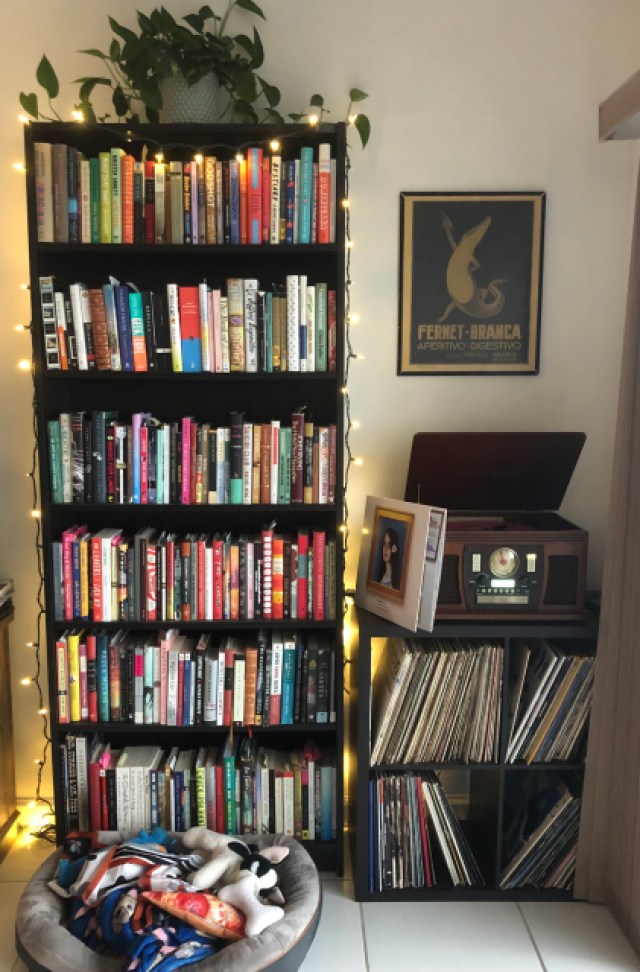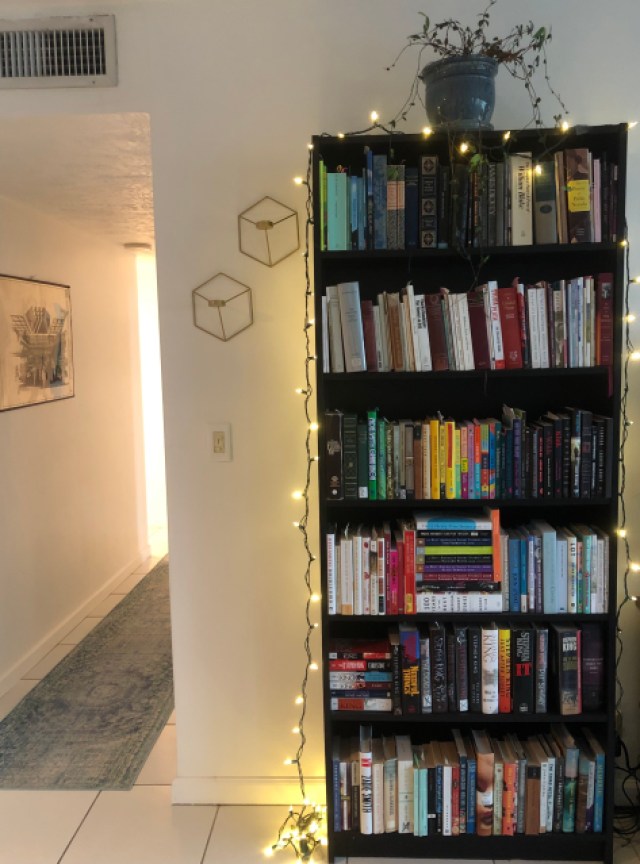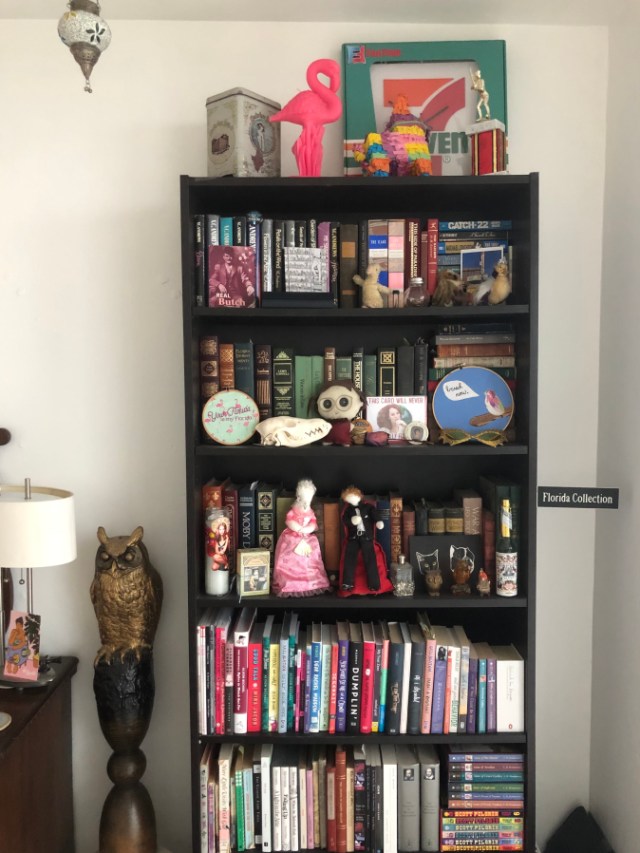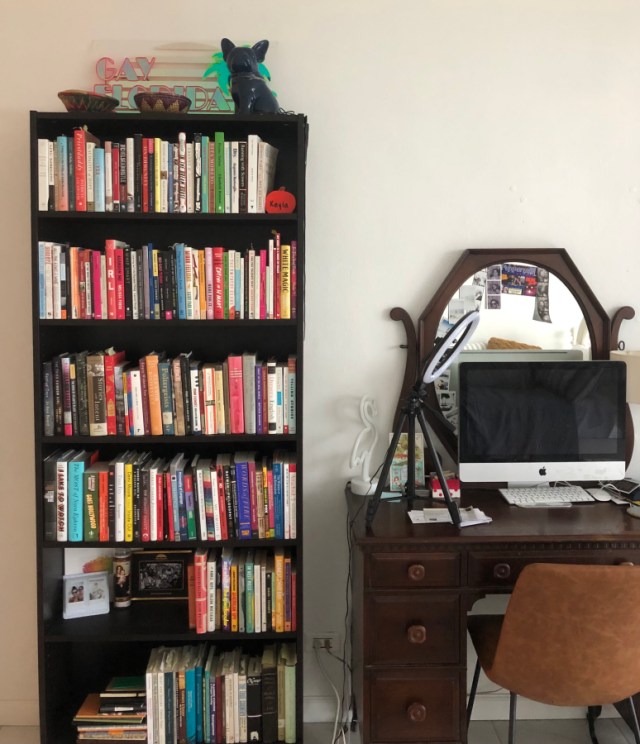Spaces & Places is a three-week series focusing on the private and community areas we occupy, the ways we personalize them, and the meanings that we assign to them. Organized and edited by Meg Jones Wall.
I thought it was going to be harder.
My girlfriend and I took a circuitous path to moving in together. After several months of long-distance, Kristen invited me out to Las Vegas where she’d received a writing fellowship. I flew to Orlando with two suitcases, and we drove across the country with her little dog and as much stuff as we could stuff into her car. In my grandparents’ unfinished basement in Virginia, I left behind most of my belongings—including all of my books minus my copy of Ducks, Newburyport, which I for some deranged reason thought would make a good road trip book. We didn’t need much in Vegas. We were only supposed to be there for a semester.
Then COVID-19 hit, and we ended up stuck in Vegas for a strange summer beyond her fellowship. Even before that though, I felt unmoored without my books. I’d never been away from them that long. When I lived in Los Angeles, I sublet a furnished room so small I had to keep my books in the trunk of my car. They rattled around as I drove, but at least they were close. In Vegas, I certainly wasn’t without books. We lived above an independent bookstore, and we filled the ladder-style bookcase in our loft before the pandemic even hit.
But I didn’t have the books that had become my north stars. My compendium of Annie Baker plays. My essential Dykes To Watch Out For. A very worn copy of Interpreter Of Maladies. My post-it-note-filled copy of Heartburn. A book on lesbian erotics in writing I found at a thrift store. And ones I didn’t even know meant so much to me until they weren’t around, like my copy of Wishful Drinking by Carrie Fisher from high school that’s bizarrely, obsessively dog-eared in multiple places by a past version of myself, including every single page that has the word “gay” on it.
It took another cross-country road trip, a couple months in a temporary place in Orlando, and several rounds of stressful pandemic apartment hunting before we found our first place to truly, for real, permanently move in together. We bought new things together for our apartment in Miami, and we moved my girlfriend’s things in, including her three classic, black Billy bookcases from IKEA and several boxes of her personal book collection. We got plants. I decorated the kitchen. The rooms filled and came to life. Those bookcases looked magnificent. But so many of my things were still nearly 1,000 miles away, including my books. I saw the crowded bookcases and projected too much onto them, an anxious thought prodding at me: Was there any room left for my things? For me?
Figuratively and literally, there was plenty of room for me in our life. Just because I didn’t have all my things moved in didn’t mean this space wasn’t as much mine as it was Kristen’s. We’d made decisions together. We’d built furniture together. In fact, our shared aesthetics (think: cozy and modern meets Florida kitsch?!) made the homemaking process rather seamless.
And yet, I was all worked up over the books. I’d never dated another writer before or anyone with an extensive book collection for that matter. I thought it would be hard if not outright impossible to merge my books with my girlfriend’s. The three bookcases were nearly full. Would mine have to stay partially stowed away in boxes? Even if we found the space, what would it look like to bring our books together? Did they need to be separate like our closets? I know a couple that keeps permanently separate bookshelves. I don’t judge them for it, but it wasn’t what I wanted. Writing and books feel like a significant part of this relationship, and I know it’s important to have divisions and individualism within relationships, but I also couldn’t imagine drawing these hard lines. My books, your books. It’s not like I want to claim anything of hers for myself. I just want our books to be able to live together, like us. Books peacefully cohabitating, smashed together on shelves. It sounded genuinely intimate: our books, touching.
I guess it’s what Kristen wanted, too, because separate shelves were never even suggested. We were once again on the same page.
The tension, instead, came later.
My girlfriend was more than happy to conjoin our books, but she had some rules. She is, after all, a librarian. I anticipated we’d have some sort of shelving system, which I’d admittedly never really had or been able to stick to in the past. I was game though, ready to be more mature and sophisticated in my bookshelf tendencies rather than just indiscriminately throwing books where they fit.
My mother drove down from Virginia with my books and the rest of my belongings I’d been without for over a year. With some Facebook marketplace luck and an assist from my mom’s SUV, we got a fourth Billy bookcase to match the others. A very commanding and nosey Leo, my mother insisted upon assisting with organizing our books. Thus sparked the first tricky step of merging bookshelves: dealing with my bossy mother. The pandemic meant, for better or worse, we hadn’t had to deal with a lot of family stuff in our immediate space for much of our relationship. Kristen took my mother’s forwardness in stride though. I knew she loved me when I saw how chill she was about my mom throwing our books wildly around our living room.
When my mother suggested we organize our books by color or at least have “one designated red shelf,” I was nothing short of horrified. I’ve of course seen the color blocking books trend on Instagram and in some of my friend’s homes, but it makes no fucking sense to me, and I was quick to say so while also taking it a step further to call it stupid. My mother proceeded to organize by genre per my instructions but didn’t relent entirely. She still threw a random shelf in the middle of one of the bookcases just for red covers, regardless of genre. It was easier to just let her do it and fix it after she left.
When Kristen and I disbanded the red books and reallocated them to their respective shelves, I made more fun of my mother and, by extension, anyone who sorts books by color. I expected agreement, but Kristen offered something else. She said the color system probably works for my mother, a very visual and aesthetic-driven person who is more likely to remember what a book looks like than the first and last name of who wrote it. It works for other people, too. There’s no one right way to shelve, she told me. From her, I’ve learned that so much of library work responds to the specific needs of the community. If a color system makes the most sense to my mother, that’s all that matters.
After all, I’ve come to realize even our system isn’t perfectly straightforward. It goes something like this:
There are two bookcases in the living room. The one on the right houses novels sorted by author last name, A-R. On the left, the first two shelves contain poetry unsorted by name. The next two shelves contain unsorted short fiction. The fifth shelf is the Stephen King shelf. The bottom shelf continues with novels by authors with S-W names. In the office, two more bookcases. On the right, you’ll find Kristen’s extensive V.C. Andrews collection, classics, a shelf for graphic narrative and YA, plays, and vintage books. On the left, the fourth bookcase we added to the mix starts with four shelves of unsorted nonfiction we’ve been meaning to sort loosely into subgenres (memoir, essays, reference/history, theory, craft). We’ll get to it one day (I keep saying to myself). The second-to-last shelf finishes out the novels by authors with W-Z names. The bottom shelf is an odd pairing of books Kristen used for her thesis on Flannery O’Connor and a stack of my journals.

Novels by author name A-R

Poetry, short fiction, Stephen King, novels by author name S-W
It sounds topsy-turvy on paper. Why do our novels break in such nonlinear ways? Why does modern YA live among the classics—the spine aesthetics of those respective groups strikingly discordant? Why organize novels by last name but not short fiction? None of these questions really matter if this much is true: We both can locate books without having to scan shelves for longer than a few seconds. Everything has its place. The system works for us, because it is ours.
Each bookcase is also a home of its own. Aside from the books they hold, each has its own decor, too. Plants sit atop the bookcases in the living room, while the office bookcases hold miscellaneous things meaningful to each of us: some goofy like Kristen’s 7-Eleven novelty clock and my childhood softball trophy from 1999, some sentimental like bowls woven by my cousin in India and gifts from Kristen’s friends. Decorative pennants from one of my best friends adorn the office bookcases, and an unlit, massive flamingo candle gifted to Kristen for her book launch is perched on one, too, its coloring slightly faded by the Miami sun. A dried rose from the rainbow bouquet I sent her on the same occasion rests on a bookcase amid taxidermy, embroidery, miniature owl figurines, postcards, and costume glasses I got at a junk shop in Venice beach when I was probably 13. It’s a collage made of both of us.

V.C. Andrews, classics, graphic narrative, YA

Nonfiction, novels by author name W-Z, Flannery O’Connor, journals
So we got all our books on the shelves with minimal conflict. But my library lessons weren’t over. In the coming weeks, a new challenge arose. The bookcases were filling up. Shelf space was dwindling. Our short fiction shelves became so packed it was difficult to actually pull a book out. But shelf scarcity didn’t seem to faze Kristen. She calmly explained we would just have to get rid of some books to make room for new ones.
I did not calmly respond to this. I cried.
We were both surprised by my reaction. We didn’t have a full-on fight, but it was fraught. We simply weren’t on the same page. I thought Kristen was asking me to make sacrifices. We all have relationship baggage, and one of the various dilapidated suitcases hauled in from my relationship history contains imbalanced sacrifices masked as compromises. I like to compromise in relationships, but that’s sometimes at odds with my history of letting partners bulldoze over my wants and needs. In recent years, I’ve learned the line between being easy-going and being a pushover.
She wasn’t asking me to dump a bunch of my beloved books in the garbage. She especially wasn’t suggesting my books had to go while hers could stay. First of all, the books would be donated. But also, if I wanted to keep every one of my books on the shelf, I could. She didn’t want me to get rid of anything that mattered to me. But I needed to understand space on our bookcases was finite, something I was clearly in denial about. If more books were coming in, some would have to go. Kristen, with her library brain, constantly reassesses which books she actually needs to keep and which she can send to a friend or donate. If you know you’re never going to read a book again, why hold onto it?
It’s a very simple lesson. But it cracked something open for me. Books can be replaced. Parting ways with them just means re-homing them. There’s no reason we need multiple copies of the same damn book. Bookshelves might have finite space, but they aren’t fixed, not really. They’re dynamic, evolving spaces. They’re homes. Expanding a book collection also requires culling. When we add new books, we shift the shelves. Room can always be made for the things we love. There will always, always be space for me in our home.
When it came to combining our books, I’d been the one nervous about problems, but I was the problem. I erroneously assumed Kristen would be more difficult. She’s the librarian! She must have so many rigid ideas about how books are organized and displayed! I should have known better. Ever since the early days of our relationship when she still wrote a column on libraries, I’ve learned that a lot of what I previously thought about libraries was wrong. If anything, being a librarian makes her more fluid and unpretentious when it comes to books and how to arrange them. She knows how to adapt to the needs of the community which, in this case, looks like our shared home. Our books, like our lives, can mesh in ways that might not make complete logical sense from the outside. So long as it makes sense to us.



As a lesbian bookworm this piece felt very close to heart
<3
As a gay librarian myself who has finally come around to culling in my own shelves (but was horrified before)I feel really seen by both sides of this
looove this <3
I’m trying to cull a few of my books and papers in preparation for a cross-country move, and yikes! I feel this so much!
❤️📚❤️📚❤️
Kayla, I loved this! What a delight to read. It reminds me of the first essay in Anne Fadiman’s Ex Libris, where she talks about combing bookshelves with her husband finally after several years of marriage.
I used to reorganize my books for fun in Jr high and high school and one of my favorite things is seeing other people’s book systems. I read a lot of genre fiction, especially scifi, so I often like to split my fiction a bit by genre.
I adore Dykes to Watch Out For, Interpreter of Maladies, and Heartburn, so I think I’m going to have to read some Anne Baker plays!
is being a librarian even a viable option career-wise anymore? I feel like I missed the window!
It is but you have to be honest with yourself, what sort of library you want to our would be willing to work in, and be prepared to move. My best advice is to get your MLIS as cheaply (or free!) as possible because the pay will never be commensurate with the expense of the degree.
I was going to comment more or less the same. I work in a science library at a university, and we tend to get fewer applicants for those positions, for example. Talking to people doing work you think might like is extremely helpful and give you a better sense of the job market. Librarians are often happy to talk with people about their work.
Awww! As a queer librarian, this was a really sweet read! Thanks for sharing with us.
Libraries often will weed books in the cover of darkness because community members don’t always appreciate the value of it
“We both can locate books without having to scan shelves for longer than a few seconds. Everything has its place. The system works for us, because it is ours.”
Oof, is this good.
Glad to meet other people with a Stephen King shelf and a need to always be near their Essential Dykes to Watch Out For collection!
My wife also briefly worked at a library here in Tampa and we also have bookshelf-combining-and-purging angst. This essay was wonderful and reminds me to take stock of my bookshelves soon.
“She calmly explained we would just have to get rid of some books to make room for new ones.
I did not calmly respond to this. I cried.”
Ahahaha bless, this is every library worker who has ever had to have a conversation about deaccessioning with a library user.
I’m glad that a) you worked through it so beautifully in your relationship and b) that she did not respond how I often wish I could, with the gremlin who lives in my heart screeching “NOBODY WANTS YOUR BOOKS JUST RECYCLE THEM”
(just clarifying, I don’t actually say this to people, I just think it when I don’t want to go through a professor’s lifelong collection of books that are very important to them but not very relevant to our current collection or are in bad shape etc. etc.)
here for librarian pain. no need to clarify a thing – only the most crass could imagine less than tact and aplomb when you folks encounter our peccadillos.
Kayla I LOVED this and I relate to it SO HARD.
My gf moved into my place during the pandemic, and while making room for her clothes in the closet and her gadgets in the kitchen was totally fine, it was a lot harder to make room for her books on my bookcases – my three tall, black, impeccably organized Billy bookcases, btw. Luckily between the two of us, I’m definitely the bigger reader/book hoarder/organizing snob, so there wasn’t so much to make room for, and she let me basically do it however I wanted.
FYI, my organizing system, if anyone cares, is:
11 shelves of novels, fiction and non-fiction, organized by author last name A-Z
2 shelves (one each) of knickknacks and decor and a “memory box” of nostalgic papers
1 shelf of plays, poetry, graphic novels, and Broadway playbills
1 shelf of yearbooks, journals, borrowed books, and “miscellaneous”
1 shelf that is just my Norton Anthology of English Literature and other English lit and Theatre History textbooks
2 shelves of out-of-date legal textbooks I can’t bear to give away considering the hundreds of dollars they cost me
1 separate shelf in the living room (not on the Billy’s in the den) of “coffee table books”
But oh my god reading this and seeing your categories is making me want to reorganize my bookshelves all over again – sounds like the perfect Saturday night!
My books are sorted by imaginary author conversations in my head. Like, Lorraine Hansberry next to Mary Oliver because they both dated/were partnered with Molly Malone Cook. I feel like Dorothy Allison would be great at a dinner party with them, so she’s shelved nearby. Robin Wall Kimmerer and Annie Dillard in another corner near Mary Oliver. In another area, Francesca Lia Block near Michelle Tea near Maggie Nelson. Paula Vogel and Tony Kushner. I work in libraries so I don’t own a ton of books (because — libraries), but my shelving style is all mine.
Yes! I shelve books by characters and their needs! So Minnie Bruce Pratt’s S/He is next to Leslie Feinberg’s Stone Butch Blues, The Ballad of the Sad Cafe is next to Trash: Stories by Dorothy Allison, and the little girl who was molested in Maureen Brady’s short story in the collection The Question She Put To Herself is next to Healing the Whole by Yvette M. Pennacchia. The Bluest Eye, The Color Purple, and The Pearl Bastard by Lillian Halegua are all next to Crossing the Boundary: Black Women Survive Incest.
Those last ones were the beginning of this practice. The urgency I felt to help the characters heal was so potent and I had the booked they needed, so I simply put them together, touching, so they could have the life-saving osmosis permanently.
Love this!
When combining bookshelves with my own librarian, our biggest point of contention has been whether the books need to align with the front edge of the shelf or if it’s okay to push them back a little and use the front of the shelf for knickknack storage. Very excited to see your shelves display a compromise!